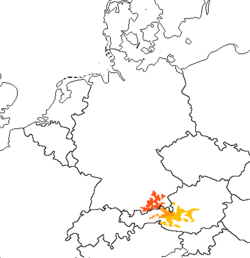Vaand: Difference between revisions
(Created page with "{{Infobox language |image=Alpiak.png |imagesize= 250px |name= ''Vaand language'' |nativename=''dà Vaandülg'' |pronunciation=/ˈvaːn.dʉlg/ |- |creator=User:Raistas|Raista...") |
m (→Vowels) |
||
| (2 intermediate revisions by the same user not shown) | |||
| Line 30: | Line 30: | ||
==Phonology== | ==Phonology== | ||
===Vowels=== | ===Vowels=== | ||
There are twenty one vowel, most of which create long-short vowel pairs. | There are twenty one vowel, most of which create long-short vowel pairs. The close-mid short vowels are sometimes considered allophones of the close short vowels, since they are present only before a consonant cluster and the standard language usually does not reduce those clusters in speech, except for clusters with an initial "r" (which in most dialects is silent there). | ||
Vaand has a front-back [[w:Vowel harmony|vowel harmony]] for all vowels, except /i/, /a/ and /ə/, which are considered neutral. Like the other Oronaic languages, Vaand has a rich system of diphthongs, that are also influenced by vowel harmony. | |||
{| | {| | ||
| | | | ||
| Line 101: | Line 103: | ||
|} | |} | ||
|} | |} | ||
{| class="wikitable" style="text-align:center" | |||
|+Diphthongs | |||
|- | |||
! Spelling | |||
! Pronunciation | |||
|- | |||
| ie || iə̯~iː | |||
|- | |||
| uo || uo | |||
|- | |||
| ui || ʉɪ | |||
|- | |||
| ei || aɪ | |||
|- | |||
| ai || ɒɪ | |||
|- | |||
| au || ɒʊ | |||
|- | |||
| eu || øɪ | |||
|- | |||
| ea || ɛɐ~ɛː | |||
|- | |||
| oa || ɔɐ~ɔː | |||
|- | |||
| äi || æɪ~ɛɪ | |||
|- | |||
[[Category:Languages]] [[Category:Alpatho-Hirtic]] | |||
Latest revision as of 10:50, 6 January 2019
| Vaand language | |
|---|---|
| dà Vaandülg | |
 | |
| Pronunciation | [/ˈvaːn.dʉlg/] |
| Created by | Raistas |
| Setting | parallel Earth |
| Ethnicity | Carpathian people |
| Native speakers | 220 000 (2012 census) |
Early forms | Proto-Oronaic
|
The Vaand language (native name - dà Vaandülg) is one of the last two Alpian languages spoken by the Vaan people in Austria. It has approximately 220 000 native speakers (including speakers of North Vaand).
In the medieval times Vaand was dialectally diverse consisting of at least three major dialectal groups, however only two distinct dialects have survived to present days. Vaand is written in the Latin alphabet and in general is very similar to German alphabet which it has evolved from.
Linguistically Vaand is classified as a nominative-accusative language. Its phonology is similar to the phonology of neighbouring Austrian dialects of German, that influenced Vaand during all of its history. It is unique for the Alpian region, since it is a non-Indo-European language and its verb conjugation system is much more complex than in its neighbours. Vaand also has case clitics in nouns and a polypersonal agreement in verbs. Typologically it is between fusional and agglutinative languages and has a complex inflection system for nouns, adjectives, pronouns, numerals and verbs, depending on their roles in the sentence.
History
Phonology
Vowels
There are twenty one vowel, most of which create long-short vowel pairs. The close-mid short vowels are sometimes considered allophones of the close short vowels, since they are present only before a consonant cluster and the standard language usually does not reduce those clusters in speech, except for clusters with an initial "r" (which in most dialects is silent there).
Vaand has a front-back vowel harmony for all vowels, except /i/, /a/ and /ə/, which are considered neutral. Like the other Oronaic languages, Vaand has a rich system of diphthongs, that are also influenced by vowel harmony.
|
| ||||||||||||||||||||||||||||||||||||||||||||||||||||
| Spelling | Pronunciation |
|---|---|
| ie | iə̯~iː |
| uo | uo |
| ui | ʉɪ |
| ei | aɪ |
| ai | ɒɪ |
| au | ɒʊ |
| eu | øɪ |
| ea | ɛɐ~ɛː |
| oa | ɔɐ~ɔː |
| äi | æɪ~ɛɪ |